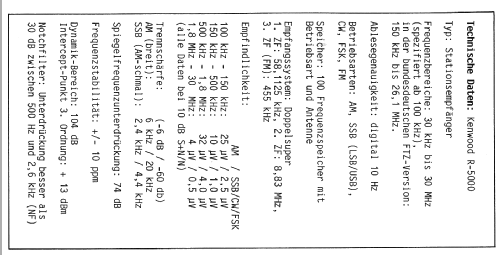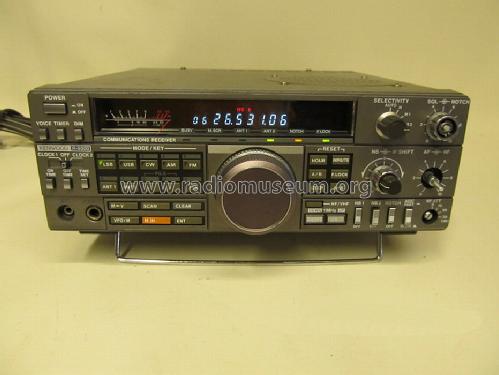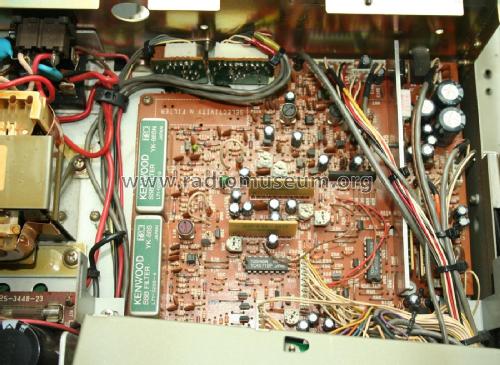- País
- Japon
- Fabricante / Marca
- Kenwood, Trio-Kenwood Inc.; Komagane
- Año
- 1987
- Categoría
- Receptor para radioaficionados (puede incluir bandas de radiodifusión publ.)
- Radiomuseum.org ID
- 81346
-
- alternative name: Trio Corp.
- Brand: Jennen
Haga clic en la miniatura esquemática para solicitarlo como documento gratuito.
- Numero de transistores
- Hay semiconductores.
- Semiconductores
- Principio principal
- Superheterodino doble o triple conversión; ZF/IF 58115/8830/455 kHz
- Gama de ondas
- Bandas de recepción puestas en notas.
- Tensión de funcionamiento
- Red: Corriente alterna (CA, Inglés = AC) / 120; 230 Volt
- Altavoz
- Altavoz dinámico (de imán permanente)
- Potencia de salida
- 1.5 W (unknown quality)
- Material
- Metálico
- de Radiomuseum.org
- Modelo: R-5000 - Kenwood, Trio-Kenwood Inc.;
- Forma
- Sobremesa de cualquier forma, detalles no conocidos.
- Ancho, altura, profundidad
- 269 x 96 x 269 mm / 10.6 x 3.8 x 10.6 inch
- Anotaciones
- Kenwood Communications Receiver R-5000.
Coverage 100-30000 kHz; AM, USB/LSB, CW, FM; digital readout 10 Hz; direct keypad frequency entry; 100 memories; clock/timer, IF-shift; notch. External power supply 13.8 V possible.
Optional: external speaker SP-430; VHF converter VC-20 covering 108-174 MHz; voice synthesizer; RS-232 port and different IF-filters.
- Peso neto
- 5.4 kg / 11 lb 14.3 oz (11.894 lb)
- Precio durante el primer año
- 2,248.00 DM
- Procedencia de los datos
- Shortwave Receivers - Past & Present (3rd ed.)
- Mencionado en
- beam Amateurfunk-Geräteführer '90
- Documentación / Esquemas (1)
- Funkschau (11/1987, S. 28 - 30 / Erfahrungsbericht)
- Autor
- Modelo creado por Martin Bösch. Ver en "Modificar Ficha" los participantes posteriores.
- Otros modelos
-
Donde encontrará 902 modelos, 836 con imágenes y 251 con esquemas.
Ir al listado general de Kenwood, Trio-Kenwood Inc.; Komagane
Colecciones
El modelo es parte de las colecciones de los siguientes miembros.
Literatura
El modelo está documentado en la siguiente literatura.
Contribuciones en el Foro acerca de este modelo: Kenwood, Trio-: R-5000
Hilos: 2 | Mensajes: 3
Hello,
I tried to upload a schematic of this short wave receiver, but got a message the file being to big. The size of the pdf file is 1.5MB. How can get around this problem?
Thanks, Miklos
Miklos Cseke, 30.Sep.10
Der R-5000 enthält einen 3V-Akku (CL2020) als Backup für die beiden Uhren sowie den Speicher für 100 Frequenzen. Mit der Zeit verliert dieser Akku seine Kapazität.
Dieses fällt erst auf wenn der R-5000 mehrere Stunden vom Netz getrennt war (Der POWER-Schalter auf der Frontseite schaltet nur die internen 12VDC) In diesem Fall bleiben die internen Uhren stehen, die Memories sind noch nicht betroffen.
Der Ersatz des CL2020 ist wegen der Einbaulage hinter einem Abschirmblech auf der "Control-Unit" als Teil der Frontplatte sehr zeitaufwendig.
Der CL2020 ist ein 3V Akku mit 20mm Durchmesser, 2mm dick mit Lötfahnen. Alle Details findet man im "R-5000 Service Manual" von Kenwood (Gab es 1988 gedruckt und heute wohl im Internet als *.pdf).
Eine einfache Lösung ergibt folgender Umstand:
Die Anschlüsse des CL2020 sind direkt mit dem Netzteil (AVR-Unit) verbunden. Diese AVR-Unit lässt sich mit wenig Aufwand ausbauen.
Hier habe ich zwei in Serie geschaltete 1.2V Ni-MH AA-Akkus angeschlossen. Natürlich ist dies von der Kapazität her ein Overkill, aber in einem Batteriehalter für 2xAA passt das Ganze perfekt in das Blechfach der optionalen Voice Synthesis Unit (VS-1).
Das Ganze funktioniert seit fast einem Jahr einwandfrei.
Bei Interesse kann ich weitere Details hierzu liefern.
Klaus Eggert, 03.Apr.09
















